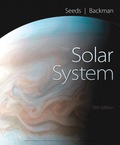
Horizons: Exploring the Universe (MindTap Course List)
14th Edition
ISBN: 9781305960961
Author: Michael A. Seeds, Dana Backman
Publisher: Cengage Learning
expand_more
expand_more
format_list_bulleted
Textbook Question
Chapter 16, Problem 14RQ
How Do We Know? Why is heat flow the key to understanding a planet’s surface activity?
Expert Solution & Answer
Want to see the full answer?
Check out a sample textbook solution
Students have asked these similar questions
Which of the following planetary traits is well established?
choose one of the following:
a) Mercury has a similar compositon to that of our moon, in that they both have a substantial metal content.
b) Venus rotates more rapidly than Earth, but in the opposite direction.
c) Earth's atmosphere exhibits a slightly stronger greenhouse effect than that seen on Venus.
d)Astronomers have precisely calculated the mass of Mercury thanks to artificial satellites sent from Earth.
1. Which of the following STILL significantly heats the Earth's interior?
a.
bombardment
b.
compression
c.
radioactivity
d.
differentiation
2. Both the Moon and Mercury have
a.
volcanic craters only
b.
impact craters only
c.
some volcanic and some impact craters
Chapter 16 Solutions
Horizons: Exploring the Universe (MindTap Course List)
Ch. 16 - Why would you include the Moon in a comparison of...Ch. 16 - In what ways is Earth unique among the Terrestrial...Ch. 16 - What are the four stages of planetary development?Ch. 16 - How do you know that Earth differentiated?Ch. 16 - How are earthquakes in Hawaii different from those...Ch. 16 - Prob. 6RQCh. 16 - How do island chains located in the centers of...Ch. 16 - Prob. 8RQCh. 16 - H does the increasing abundance of CO2 in Earth’s...Ch. 16 - Why would a decrease in the density of the ozone...
Ch. 16 - Prob. 11RQCh. 16 - Prob. 12RQCh. 16 - Prob. 13RQCh. 16 - How Do We Know? Why is heat flow the key to...Ch. 16 - How Do We Know? In what ways have scientists been...Ch. 16 - Prob. 1DQCh. 16 - Prob. 2DQCh. 16 - Assume P waves travel at 10 km/s and S waves...Ch. 16 - Earth’s metallic core has about 55% of the...Ch. 16 - Prob. 3PCh. 16 - Prob. 4PCh. 16 - Prob. 5PCh. 16 - Earth is four times lager in diameter than its...Ch. 16 - The smallest detail visible through Earth-based...Ch. 16 - Prob. 1LTLCh. 16 - Prob. 2LTLCh. 16 - Prob. 3LTLCh. 16 - Prob. 4LTLCh. 16 - Prob. 5LTL
Knowledge Booster
Learn more about
Need a deep-dive on the concept behind this application? Look no further. Learn more about this topic, physics and related others by exploring similar questions and additional content below.Similar questions
- What is the smallest-diameter crater you can identify in the photo of Mercury in Figure 2 of the Concept Art: Terrestrial and Jovian Planets? (Hint: See Appendix Table A-10, Properties of the Planets, to find the radius of Mercury in kilometers for scale.)arrow_forwardWe believe that chains of comet fragments like Comet Shoemaker-Levy 9’s have collided not only with the jovian planets, but occasionally with their moons. What sort of features would you look for on the outer planet moons to find evidence of such collisions? (As an extra bonus, can you find any images of such features on a moon like Callisto? You can use an online site of planetary images, such as the Planetary Photojournal, at photojournal.jpl.nasa.gov.)arrow_forwardHow might Venus’ atmosphere have evolved to its present state through a runaway greenhouse effect?arrow_forward
- What evidence can you give that Venus once had significant amounts of water? Where did that water come from? Where did it go?arrow_forwardWhich planet has the strongest magnetic field, and hence the largest magnetosphere? What is its source?arrow_forwardWhy do small planets cool faster than large planets? Choose any two of the five Terrestrial worlds and calculate for each one the ratio of its surface area to its volume. Why is this ratio important? (Hint: Does this ratio have anything to do with the ability of a planet to lose internal heat?) (Note: The surface area of a sphere is 4r2, and the volume of a sphere is 43r3.)arrow_forward
arrow_back_ios
arrow_forward_ios
Recommended textbooks for you

 Foundations of Astronomy (MindTap Course List)PhysicsISBN:9781337399920Author:Michael A. Seeds, Dana BackmanPublisher:Cengage Learning
Foundations of Astronomy (MindTap Course List)PhysicsISBN:9781337399920Author:Michael A. Seeds, Dana BackmanPublisher:Cengage Learning An Introduction to Physical SciencePhysicsISBN:9781305079137Author:James Shipman, Jerry D. Wilson, Charles A. Higgins, Omar TorresPublisher:Cengage Learning
An Introduction to Physical SciencePhysicsISBN:9781305079137Author:James Shipman, Jerry D. Wilson, Charles A. Higgins, Omar TorresPublisher:Cengage Learning AstronomyPhysicsISBN:9781938168284Author:Andrew Fraknoi; David Morrison; Sidney C. WolffPublisher:OpenStax
AstronomyPhysicsISBN:9781938168284Author:Andrew Fraknoi; David Morrison; Sidney C. WolffPublisher:OpenStax


Foundations of Astronomy (MindTap Course List)
Physics
ISBN:9781337399920
Author:Michael A. Seeds, Dana Backman
Publisher:Cengage Learning

An Introduction to Physical Science
Physics
ISBN:9781305079137
Author:James Shipman, Jerry D. Wilson, Charles A. Higgins, Omar Torres
Publisher:Cengage Learning

Astronomy
Physics
ISBN:9781938168284
Author:Andrew Fraknoi; David Morrison; Sidney C. Wolff
Publisher:OpenStax
Kepler's Three Laws Explained; Author: PhysicsHigh;https://www.youtube.com/watch?v=kyR6EO_RMKE;License: Standard YouTube License, CC-BY